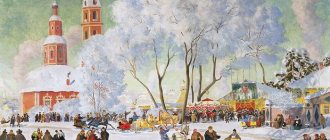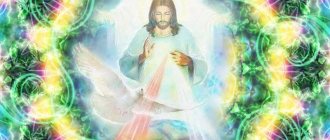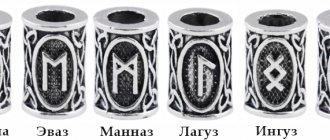Paganism is a belief in one's own gods. Pagans have their own vision of God. This belief is based on local traditions and experiences of a particular people. There are a great many pagan traditions in the world. You can try to describe some of them. Some historians believe that the revived old traditions in the 20th century are neo-paganism.
Neo-pagans are also people who consider themselves adherents of a particular faith, but do not adhere to traditions as such. Paganism is polytheism or the worship of nature. The first religion that appeared at the dawn of mankind was paganism. This worldview still exists today. Paganism is not only practiced by wild tribes and small groups of people, but it is also accepted in established, developed modern civilizations, for example, in India and Japan. The pagan worldview was also inherent in ancient countries: Greece, Persia, Rome, Egypt, and the “barbarian” northern peoples. In the modern West, some adherents of neo-paganism are promoting its recognition on a par with generally accepted world religions, such as Christianity, Buddhism, Islam, and Judaism.
Pagans can be divided into three categories. Some worship nature, others worship many gods, and others worship one god or goddess.
Reverence for nature
Pagans recognize a place, such as a mountain, lake or spring, as a divine place that they worship. This place has its own deity who guards it. For example, the goddess Athena is the patron saint of Athens. And the changing seasons with various natural manifestations serve as a model of spiritual growth and renewal. Holidays are also celebrated according to certain cycles, during which pagans communicate with their deities corresponding to different seasons. For many pagans, the Earth is also sacred. They bring gifts to her, for example, they pour the wine of the first harvest into the ground or bury some food or things in it, wanting to receive a rich harvest from the earth.
"Old" religion in England
Could traces of the "old" religion - a body of beliefs and practices of Germanic-Scandinavian origin dating back to the period before the Christianization of the island - be seen in the religious traditions of the Elizabethan period? Many researchers answer this question positively, but some clarifications should be made here. The old gods, among whom Odin and Thor should be mentioned above all, were forgotten, and if some ancient prejudices and superstitions still remained, they belonged to the sphere of folklore - from oral traditions to psychological reactions acquired in the process of education. The importance of poetic folk art cannot be underestimated. A significant number of folk ballads, short narrative poems that were passed down orally from generation to generation and performed to music that also served for other texts, were based on ideas and beliefs that went back to the first Germanic and Scandinavian conquerors.
Diversity of Gods
A large number of deities belong to various manifestations of nature. For some peoples, for example the Greeks, the gods are a community similar to people, with their way of life and relationships. And the worshipers of Osiris and Isis worship one god or goddess as the Great God who keeps the secret of the Universe. Many pagans believe that there is some divine principle, the source of all things. But all pagans recognize a plurality of deities, for by coming into contact with a large deity, the small one also becomes divine, and not partially, but completely. Pagans who believe in one deity are not monotheists who recognize only one supreme deity, but henotheists who believe in a higher divine principle.
Pagans
The word “pagan” or “pagan” is heard more and more often. The people are slowly but surely waking up. Wakes up from a thousand-year stupefying sleep. A dream that, like a cloud, shrouded many generations of our ancestors. All! The night of Svarog has come to an end. It's early morning outside!
In many clans, archaic knowledge has been preserved. Of course, most of them were still lost, but something still remained. The main thing that remains is an understanding of who the pagans are. And this is exactly what we will talk about today.
Pagans are people whose worldview does not fit into the framework of conventional religions, such as Christianity, Islam, Buddhism or Judaism. These are those who live according to conscience in harmony with nature, honoring their ancestors. The pagan does not worship anyone, but he honors his native gods, the first of which is the god Rod.
Paganism, most likely, can be called philosophy, because it certainly cannot be called a religion (in the traditional sense of the word). This philosophical concept has many concepts, for example: shamanism, Wicca, Druidism, etc.
Speaking about paganism, you need to understand one very important thing: it appeared long before the concept of “one god” arose, which is what we can see in the Abrahamic religions. There is a place for polytheism in the pagan world. The world of a pagan is much more complicated, because it is inhabited not only by gods, but by creatures of different orders (spirits, supernatural beings).
Paganism is characterized by tolerance in the good sense of the word. A pagan will never prove to another that his worldview is the only true one, as is common in other faiths. He will not impose his vision of life with fire and sword. Perhaps this is bad...
The basis of life for a pagan is Nature. Without Her he does not exist, without Her he is nothing. Interaction with the Elements of Nature among pagans occurs constantly. After all, as mentioned above, pagans themselves are an integral part of nature. In many practices and rituals, interaction with the forces of Nature occurs constantly. Forest, river, mountains are not just places, they are always Places of gaining Power, places where Spirits live, places where Gods live.
Belief in goddesses
Some pagans consider the female form to be divine. Most pagan cults, such as Odin and Mithras, recognize only devotion to a single male god. But they also recognize the presence of other gods and goddesses. The term "cult" refers to the worship of one specific deity or pantheon. Now this concept has expanded to mean the worship of a divine or human leader, a semi-deity. Mainstream religions such as Judaism, Christianity and Islam reject the idea of female divinity. One of the evangelical bishops once said that religions with goddesses are degenerate.
Minoan religion
For mainland Greece, finds related to religion dating back to the time before the Late Helladic period are very rare. A somewhat different situation developed in Crete - a lot of evidence of religious beliefs of the Minoan period was discovered there. For quite a long time, these archaeological finds were interpreted as evidence of the existence of a single religion based on the veneration of one or more mother goddesses, and the figurines of women discovered by researchers were considered as images of deities.
Worship of pagan gods
Often pagan deities are considered native to a certain area. Royal families in Britain trace their origins back to the god Odin. The Celtic kings traced their lineage back to the god Beli and the goddess Anna. National heroes and heroines are also deified by the people. An example of this is Julius Caesar. In paganism, families of gods are worshiped. These divine families may include ancestors long dead or those who have recently departed this world. These god-men can briefly return to the world of the living.
Deities can also be local individual spirits, for example, a snake is the guardian of the house or a bear is the owner of the forest. Deities can gather in groups, like elves or dwarves. Every nation has a special ritual to honor them. The spirit deities are presented with food or drink. Fire or water is also considered ritual. Sacrifice is offered to these divine elements. Thanks to these rituals, the continuity of the past is maintained and passed on to the future. This is the guarantor of the meaning of existence.
Modern manifestations of paganism in Russia
Neopaganism of our days is a trend that positions itself as a revival of “original Russian” traditions and beliefs. In fact, there is little left of ancient paganism there - only the names of the gods. And even those are not reliable. In 980, Prince Vladimir Red Sun systematized the pagan pantheon, wanting to strengthen his power. Each city or village had its own deities, its own spirits, its own idols and its own rituals. The information about the pagan gods that we know now is the result of the artificial systematization of religion by the prince. This system lasted only eight years, until the Baptism of Rus'.
Neo-pagans use fragmentary information about the paganism of pre-Christian Rus' that has reached us, reinterpreting them in their own way. The most active ones wear “ancient Russian” clothes, remember Slavic deities in speech, celebrate pagan holidays, and pray to the ancient gods. Less active ones limit themselves to pagan paraphernalia. Also in paganism there was and remains a strong ecological motive. The idea of being close to nature, the principle of using natural products, and the like. Due to this, neopaganism is attractive to many.
Rodnoverie
The main direction of Russian neo-paganism in the 21st century was Rodnoverie. People who have chosen this direction represent disparate communities with their own attributes and temples. They are passionate about Slavic history and traditions, use natural materials in everyday life and go to the forest for pagan holidays. According to many secular scientists, theologians and Orthodox priests, Rodnoverie has the features of a sect.
A characteristic feature of the Rodnovers is the denigration of real history and the inventing of a new history of the Slavic tribes. The ones that “actually appeared much earlier than you think!”
Rodnoverie is quite popular due to the desire to get rid of modern city bustle and a negative attitude towards politics and statehood in general. Rodnoverie combines monotheism and polytheism. The main god is Rod, the other deities are only his faces. The declared unity of man and nature adds to the attractiveness of this direction.
Church superstitions
A large and massive manifestation of pagan thinking in our everyday life can be called ritualism. This is a trend that, unfortunately, arose in the Orthodox environment. Ritualism includes belief in omens: for example, which hand to give a candle with, how many times to kiss an icon. And also mistaking church ceremonies for rituals - “I’ll light a candle, and God will help me for it.”
As St. Nicholas of Serbia said: “Just as a butterfly will not become a caterpillar again and will not return to the shell from which it flew, so we cannot return to the decayed shell of the ancient pagan faith.”
Read us conveniently on social networks:
Tags: who are the pagans, what is paganism, paganism, who are the pagans, are the pagans
Home paganism and rituals
But not all paganism is a public religion. There are many deities in household items too. For example, brownies. Not all pagan deities are in the likeness of humans. This religion covers the entire life of a person. Pagans consider Nature divine. It's not just an inanimate object. Fortune telling and magical rituals are associated with nature. They are part of the life of the pagans. People tell fortunes by the flight of birds or by the entrails of a sacrificial animal. Pagan priests and shamans ask the spirits to send them some kind of sign. These signs can only be read by initiates. They determine the course of further events, for example. By throwing stones or parts of plants, they try to unravel the pattern they make. The priests are waiting for a response from the deity.
With the help of magic, shamans and priests try to obtain the desired results from the other world. In paganism, the worlds are in close contact. To protect themselves from unwanted events, pagans make special amulets and amulets. Often from birth the child received such an individual amulet. Talismans and enchanted objects were hung on the doors and walls of houses. Before the battle, warriors performed a certain ritual aimed at victory and protection from wounds. Shamans cast spells on the enemy. Anglo-Saxon manuscripts have survived that describe such a ritual. There are also records of conspiracies aimed at a good harvest and healing. Such rituals and others like them are found in all pagan cults. Spellcasters and healers widely used them to treat livestock and people. In most cults, damaging others is prohibited.
Paganism - the religion of the ancient Slavs
Paganism is the ancient religion of the Slavs. However, religion is too narrow a concept, as has already been said. After all, paganism for our ancestors was a whole worldview system, a unique culture with its own characteristics. The religion of Slavic paganism appeared and achieved its development and independence at the dawn of the first millennium of the new era. Before this, there was a common religion for all Indo-European tribes.
Slavic religion (paganism) was a combination of the following main features:
- Deification of nature, worship of nature. This phenomenon is also called animism.
- Honoring your Family, your ancestors.
- Belief in the existence of invisible forces, both evil and good. These forces, as the ancient Slavs believed, constantly accompany a person and participate in his life.
- Belief in magic, in the power of rituals and conspiracies.
Like all pagan religions, Slavic paganism was polytheistic. For whom the terms polytheism and paganism are the same thing, synonyms. However, this is not quite true. Paganism is a larger, more comprehensive concept. This is not only belief in many gods.
But let's return to Slavic polytheism. Each of the “participants” of the pagan pantheon was responsible for one or another natural phenomenon or aspect of human life. For example, Perun is the god of thunder, Lada is the goddess of love, and so on. Each god was represented in a certain image, with his characteristic appearance and attributes.
Why did the pagans need gods? They, in fact, were peculiar representatives of nature, higher powers. Gods were not worshiped, gods were glorified. The Slavs did not ask them for forgiveness. They were asked for a good harvest, health, success in war, in love. Moreover, you had to ask the corresponding deity. For the most revered and important, pagan temples were built - temples, sanctuaries. Some kind of worship services were held there. But the mediators between gods and people were magicians and priests. They had extraordinary wisdom. Also, sacrifices or demands were made to the gods. Do not think that the victims were human and bloody. Not at all. They brought food, grain, and flowers as gifts to the gods. Holidays were held in honor of the gods.
The Slavs had a unique idea of the existing world. The god Rod was considered the One Creator. It was he who created the three worlds. Rule - the Higher world, the divine, the world of wisdom and laws. Nav is the world of the past, the world of fundamentals. Reality is the world in which people live, real, real, visible. They all pursue the goal of procreation and constant improvement.
The disappearance of paganism
At the very beginning of the new era, when global land development was taking place, all the tribes of modern Europe and Asia were pagan. However, some time later (around the eighth century), paganism began to be gradually supplanted. The peoples adhered to Christianity, Islam, and Judaism.
Why was paganism supplanted by world religions? There were several reasons for this:
- It was becoming too primitive for developing peoples. People began to understand many natural phenomena. That is, now it was impossible to explain the existence of the simplest natural phenomena by saying that “God got angry” or “the spirits wanted it.” After all, the real physical substrates of all occurring phenomena became known and understood.
- Tribes began to form states. And in any state there is always some kind of social stratification. For paganism, all people were equal before nature. This is how contradictions arose between reality and religion.
- Paganism as a religion was not suitable for state power. It did not submit to a single ruler, a monarch.
- A monotheistic religion was needed. And the world ones were just like that.
That is why the choice was made between paganism and world religions in favor of the latter. Christianity, of course, became the most widespread. Of course, the transition from paganism to other religions took quite a long time, sometimes very difficult. Particularly interesting is the phenomenon of dual faith that existed at the beginning of the second millennium in Kievan Rus.
However, we cannot say that paganism has completely disappeared from our lives. This is not true at all. Not many people know that even after the strengthening of the Christian religion in Rus', pagan traditions, customs, and signs continue to exist today. Therefore, it is sometimes said that the world religions that replaced the pagan ones were forced to partially unite with them.
Paganism (Podoprigora, 2013)
Paganism is a designation for non-theistic religious beliefs based on their opposition to theism. The theologically developed term “Paganism” cannot be an accurate and unambiguous term for scientific religious studies; Unlike the closely related modern term polytheism, which clearly refers to certain religions, “Paganism” is a designation for a dynamic tendency that colors various religions to a greater or lesser extent. Paganism also lives within the theistic religions themselves - not only as a “relic”, but also as an idea, as a hated or “seductive” image of an uncertain past that awaits the crisis of official faith in order to find a new life. Thus, without being an unambiguous term, the word “Paganism” contains rich cultural and symbolic content that is subject to descriptive disclosure.
Paganism (NFE, 2010)
Paganism is an archaic type of worldview that had a mythological expression, characteristic of various peoples who were at the pre-class or early state stage. The myth syncretically connected the religious (associated with the sacred-ritual sphere), cognitive, spiritual-practical, moral, historical, artistic-aesthetic and didactic (associated with the transmission of traditions) experience of humanity. The mythological form of the pagan worldview is the oldest necessary way of understanding reality.
Paganism (Lopukhov, 2013)
Paganism is a term of theological origin, used mainly by Christians in relation to all polytheistic, pre-Christian and extra-Christian religions. First used in the New Testament in relation to peoples (“pagans”) who worshiped several gods at once. In addition to polytheism, paganism is characterized by: a close connection with natural phenomena, with natural-economic cycles, with the most important human activities; idolatry; sacrifice; the presence of magic, divination, spells, conspiracies; ritualism; territorial isolation.











